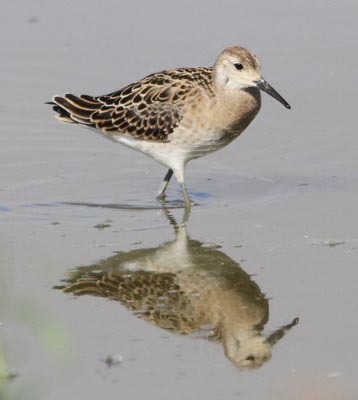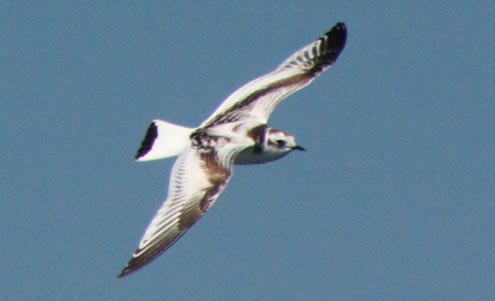These highlights chronicle the year 2012. Created
incrementally as new photos were available, the year runs generally
"backwards" on this page. The abbreviation "MTY" means "Monterey County"
in the text below. Text by Don Roberson. Photos on this page
are copyrighted by the photographers to whom they are
attributed, and may not be reproduced in any form (including
other web sites) without the express consent of the photographer. |
||||
 |
||||
Unfortunately, a young Indigo Bunting in Steve Rovell's Marina yard 22-23 Dec (right, photo 22 Dec © S. Rovell) did not stick around for the count.
|
||||
|
||||
 |
||||
While watching the gulls and squid on 24 Nov, hundreds of Pacific Loon were streaming past Pt. Pinos, and a flock of Surf Scoters (right) included a male Black Scoter (second scoter in top row, right © D. Roberson). |
||||
|
||||
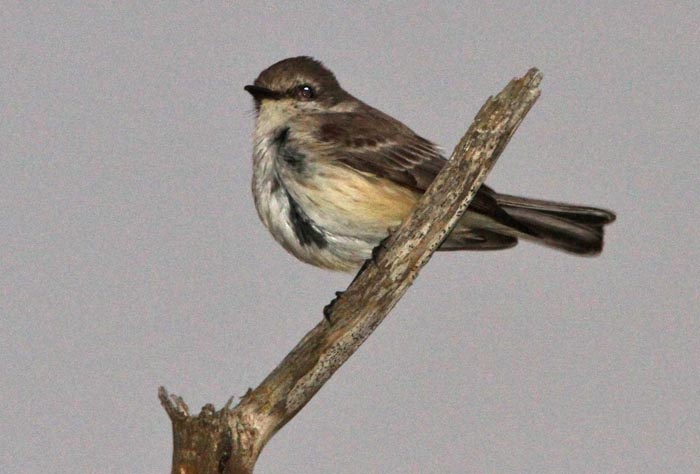 Excellent birds in November included this female (likely hatch-year) Vermilion Flycatcher
at Crespi Pond, Pt. Pinos, found by Bill Hill on 11 Nov (and
photographed here with built-in flash just at dusk, right, © D.
Roberson). Photos by Bill Hill are on his website. This is the first record
for the Monterey Peninsula proper, and the 8th for MTY as a county (4
males, 4 females). It continued to be seen daily through the
Thanksgiving weekend. Excellent birds in November included this female (likely hatch-year) Vermilion Flycatcher
at Crespi Pond, Pt. Pinos, found by Bill Hill on 11 Nov (and
photographed here with built-in flash just at dusk, right, © D.
Roberson). Photos by Bill Hill are on his website. This is the first record
for the Monterey Peninsula proper, and the 8th for MTY as a county (4
males, 4 females). It continued to be seen daily through the
Thanksgiving weekend. |
||||
This first-cycle Franklin's Gull (left © D. Roberson) was encountered with a flock of 110 Ring-billed Gulls in a strawberry field along Giberson Road, enroute to Zmudowski SB, on 4 Nov. In early November, migrant Short-eared Owls were encountered. Four were present along Moro Cojo Slough on 6 Nov (photo of a male, below left, © Rick Fournier), where they might winter. More unexpected was a migrant over Monterey Bay, 6 miles west of Moss Landing, on 4 Nov (Kate Cummings). In late October, a first-year Red-naped Sapsucker, molting from juvenal into formative plumage, was in willows at the gatehouse for Monterey Dunes Colony (photo 21 Oct, below right, © Rick Fournier). |
||||
|
||||
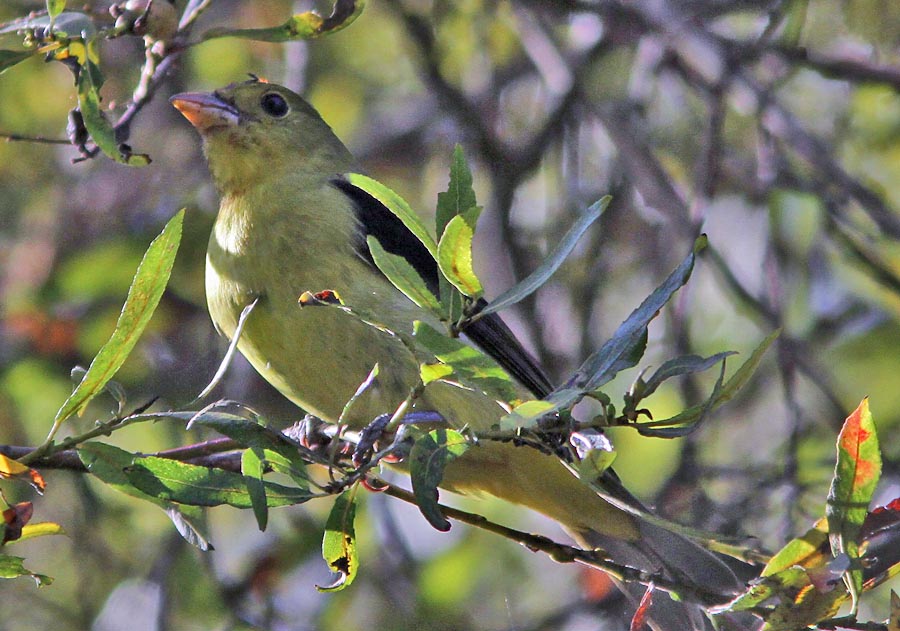 |
||||
| October continued to dazzle with a plethora of vagrants, including a young male Scarlet Tanager at Laguna Grande Park on 13 Oct (Carole & Larry Rose, Mike Stake, photo © D. Roberson). Other fine encounters included numerous Clay-colored Sparrow (one below left at Carmel R. mouth 6 Oct, © D. Roberson); a female Black-throated Blue Warbler at Moonglow Dairy on 6 Oct (photo middle below © Rick Fournier); and a few Bobolink, including this one (below right © Rick Fournier) near Salinas on 25 Sep and seen into October. Also impressive in early Oct was an huge influx of Black-vented Shearwater in Monterey Bay, many of them near shore (photo second row below from 7 Oct © D. Roberson). | ||||
|
||||
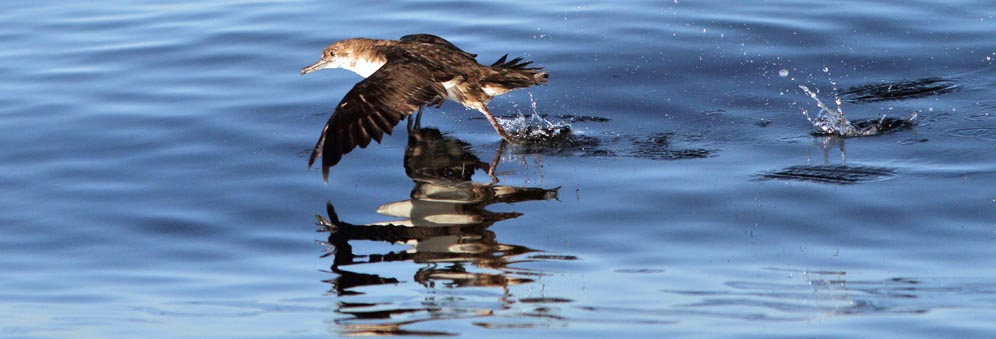 |
||||
|
||||
Numbers of eastern warblers in September were impressive, recalling autumns in the distant past. In the month between 25 Aug–25 Sep, MTY birders had located
Also very nice was a Brewer's Sparrow in a Monterey backyard on 16-17 Sep (below right, photo © Chris Hartzell). |
||||
|
||||
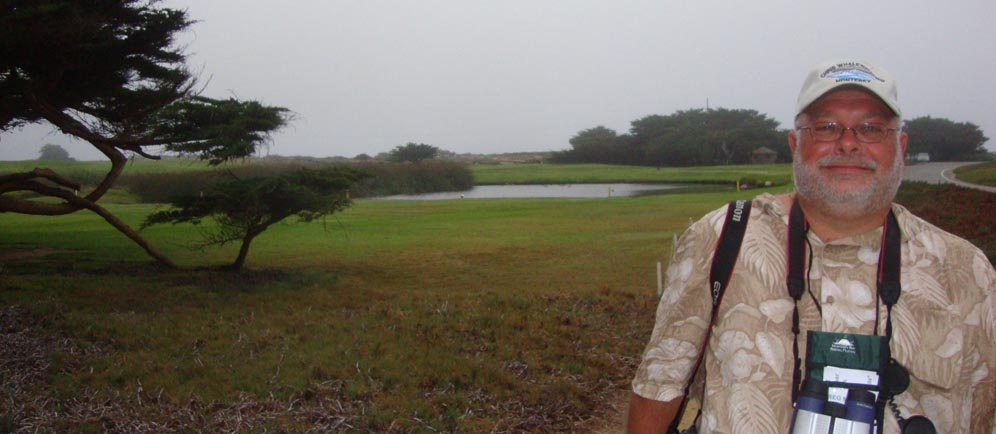 |
||||
| Another unexpected visitor to the cypresses around Crespi Pond in September was Greg Miller (above, photo 15 Sep © D. Roberson), of The Big Year book and movie fame, and the keynote speaker for the Monterey Bay Bird Festival in Watsonville this year. On the day of Greg's appearance here at Pt. Pinos, those cypresses to the left had attracted a flock of 30+ invading Red Crossbills. Greg and several locals were particularly intrigued with their vocalizations, which were distinctive from the typical "type 2" Red Crossbills that have occurred in the Monterey pines during prior invasions. | ||||
Their calls were faster, softer, higher-pitched and "wirey" in comparison to the usual, stronger "kip-kip-kip" of type 2 Red Crossbills. On 15 Sep in the Pacific Grove cemetery, I switched my digital camera to a "video" mode and shot a wild Blair-Witch-Project unviewable movie, but in the background you can hear the vocalizations at this link [just close your eyes and listen, weeding out the cries of crows]. These vocalization have been confirmed as type 3 Red Crossbill by crossbill researcher Dr. Jamie Cornelius. There are 8–10 "types" of Red Crossbills in North America, which differ in size, bill shape, vocalizations, habitat, and food preference. They may eventually prove to be multiple different species. The one that normally reaches MTY in 'invasion years' is type 2, a pine-loving population that is widespread, and includes the Sierra Nevada. Type 3 is usually a taiga species, mostly in Alaska and Canada where it prefers spruce and hemlock; see a page by Jeff Groth (and use links there to check out the original 8 types). This year a huge southward invasion of type 3 crossbills is underway across much of the northern United States. Here in Monterey County, flocks ranging from 6 to 50 birds were at numerous sites in Pacific Grove between 8-16 September. Small flocks were also seen in the City of Monterey and on the MTY side of Fremont Peak (on 13 Sep), while others have been in Santa Cruz. However, after that week, most of them have seemingly evaporated. Be sure to continue to report any crossbills you encounter this fall/winter, and more recordings would help us understand whether the entire autumn 2012 invasion is composed of just type 3 crossbills. As far as I know, this type has not been documented in MTY before. |
||||
Good migrant waders continued to be located in September. Two juvenal Ruff were present, including this male near Salinas (near right, photo 10 Sep © D. Roberson). Even better was a juvenal Buff-breasted Sandpiper at Moonglow Diary 8-11 Sep (far right, photo 8 Sep © D. Roberson). It has been quite a number of years since there was a chaseable "Buffy" in MTY. Most of our rarer shorebirds are HY (=hatch-year) individuals in juvenal plumage. Nearly all the Baird's and Pectoral Sandpipers each fall migration are such young birds. Therefore it is a treat to find a wayward adult among them occasionally. The photo below, from 10 Sep (© D. Roberson) shows an adult Pectoral Sandpiper (left-hand bird) next to a juvenal Pectoral (right-hand bird). Note the substantial differences in back and covert feathers, and in the breast pattern. |
||||
 |
||||
|
||||
| Most pelagic trips in September were reasonably good. No major State-level rarities were encountered, but highlights included numerous Long-tailed Jaegers and South Polar Skuas, a smattering of Scripps's Murrelets in warmer water eddies, and this Laysan Albatross (below), a banded individual traced to Guadalupe I., that threw water droplets everywhere upon gliding in to land behind the boat (16 Sep © D. Roberson). | ||||
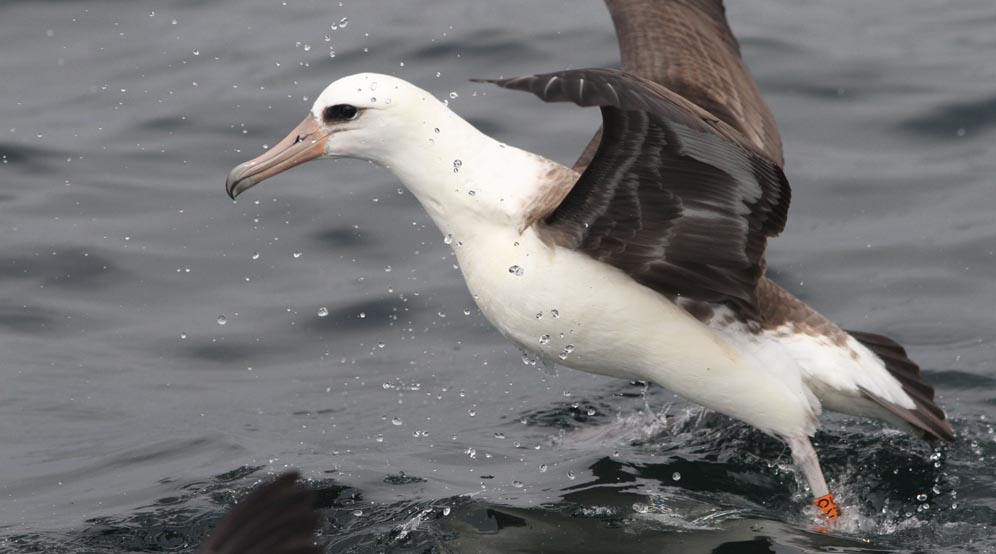 |
||||
|
|
 An amazing bird found on 27 Dec was this Brown Booby
(above, photo © Cooper Scollan). It was seen sitting at the end of
Wharf #2 in Monterey Harbor before flying off by two guys arriving to
work at the fish company at wharf's end (John Lucido, Klaus Campbell).
They did not know that the Monterey Peninsula CBC was underway that day
— but they contributed the bird of the count!
An amazing bird found on 27 Dec was this Brown Booby
(above, photo © Cooper Scollan). It was seen sitting at the end of
Wharf #2 in Monterey Harbor before flying off by two guys arriving to
work at the fish company at wharf's end (John Lucido, Klaus Campbell).
They did not know that the Monterey Peninsula CBC was underway that day
— but they contributed the bird of the count! 
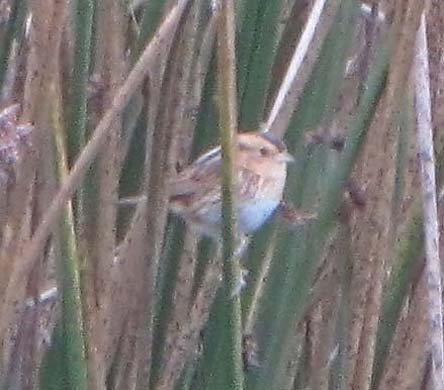
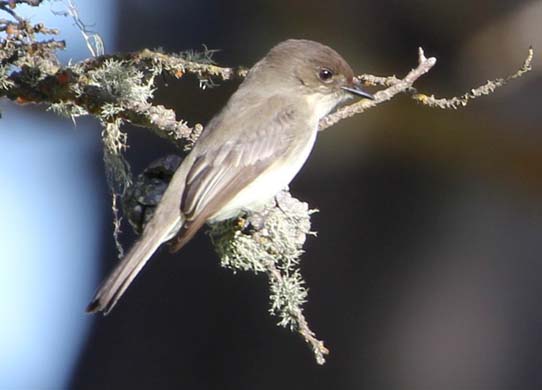
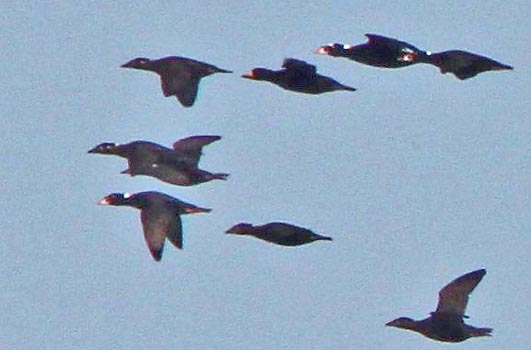 Throughout
November, dozens of Humboldt squid Dosidicus gigas were found beached
along the Pacific Grove shoreline, attracting much attention from
wintering gulls and from Brown Pelicans (above, 24
Nov © Don Roberson). According to the Monterey Bay Aquarium web
site, these large squid can grow to six feet, weigh up to 110 pounds
and feed on a staggering array of prey items. The Aquarium has captured
some healthy ones but they are very hard to maintain in captivity. This
squid appeared here during the major El Niño of 1997-98, and
some remained in Monterey Bay for ten years, then disappeared.
According to a news interview with an Aquarium scientist, this fall's
event is a mysterious re-appearance.
Throughout
November, dozens of Humboldt squid Dosidicus gigas were found beached
along the Pacific Grove shoreline, attracting much attention from
wintering gulls and from Brown Pelicans (above, 24
Nov © Don Roberson). According to the Monterey Bay Aquarium web
site, these large squid can grow to six feet, weigh up to 110 pounds
and feed on a staggering array of prey items. The Aquarium has captured
some healthy ones but they are very hard to maintain in captivity. This
squid appeared here during the major El Niño of 1997-98, and
some remained in Monterey Bay for ten years, then disappeared.
According to a news interview with an Aquarium scientist, this fall's
event is a mysterious re-appearance.
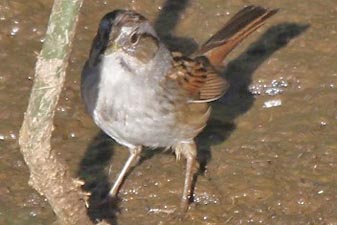
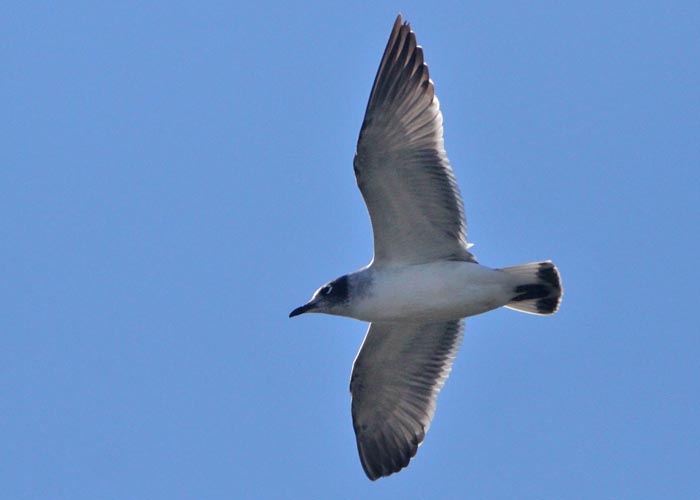
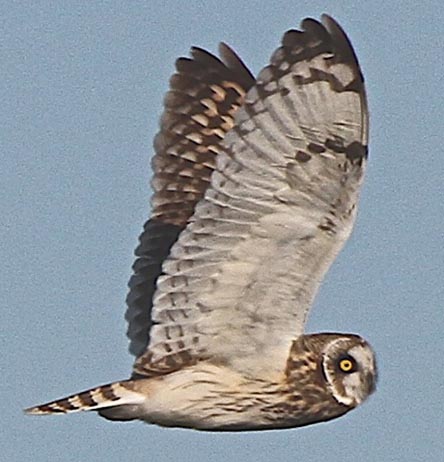
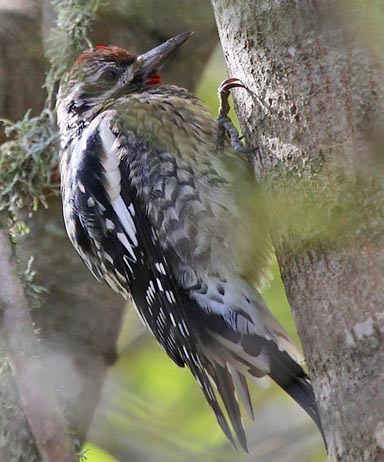
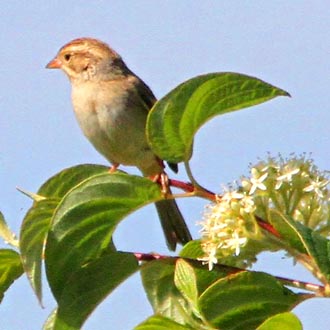
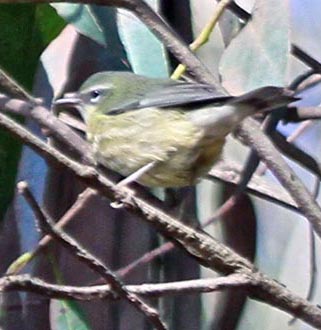

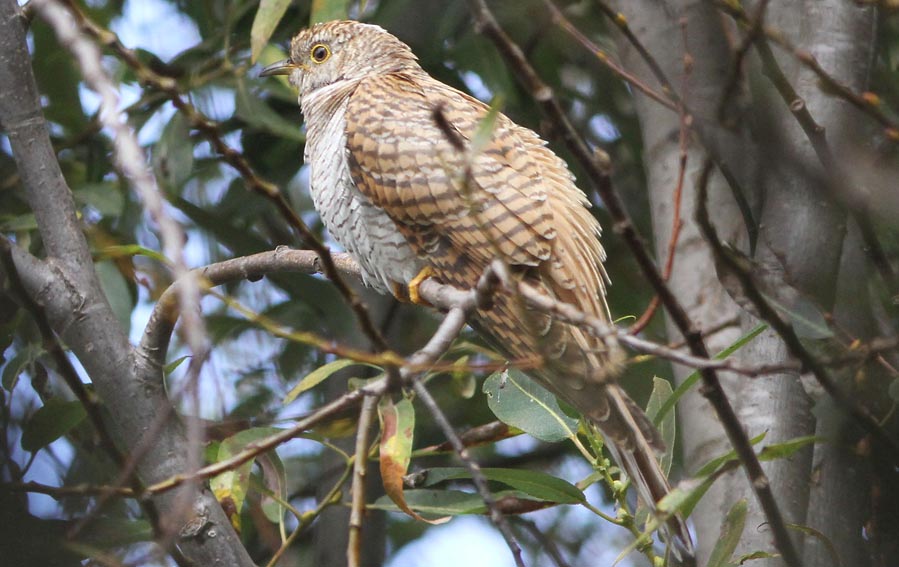
 September was good for landbird migrants, including eastern vagrants and this surprising western vagrant: a Rock Wren
at Pt. Pinos from 24 Sep on (right, photo 24 Sep © Bill Hill).
There are only 4 previous records from the Monterey Peninsula: 27 Dec
1967 Pt. Joe; 15-26 Sep 1972 Lovers Pt., P.G.; 26 Nov 1983–11 Apr 1984
Hopkins Marine Station, P.G.; and 4 Nov–31 Dec 2001 at China Rock, 17
Mile Dr., Pebble Beach. This one frequented the wave-washed coastal
outcroppings just east of the Point itself.
September was good for landbird migrants, including eastern vagrants and this surprising western vagrant: a Rock Wren
at Pt. Pinos from 24 Sep on (right, photo 24 Sep © Bill Hill).
There are only 4 previous records from the Monterey Peninsula: 27 Dec
1967 Pt. Joe; 15-26 Sep 1972 Lovers Pt., P.G.; 26 Nov 1983–11 Apr 1984
Hopkins Marine Station, P.G.; and 4 Nov–31 Dec 2001 at China Rock, 17
Mile Dr., Pebble Beach. This one frequented the wave-washed coastal
outcroppings just east of the Point itself. 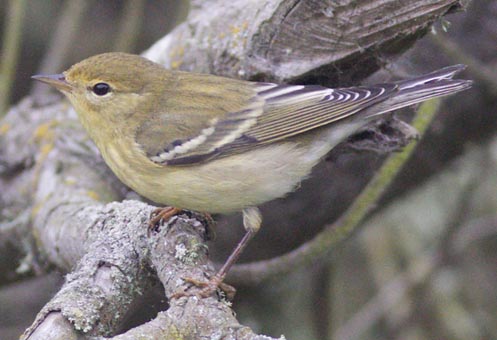

 The
flocks of crossbills included adult males, females, and younger birds.
They looked smallish, with thinner and (maybe) longer bills than the
type 2 Red Crossbills of invasions past and, in contrast to those prior
birds, these 2012 crossbills appeared to forage only on cypress cones.
A male from the 15 Sep flock is shown at left (© D. Roberson).
The
flocks of crossbills included adult males, females, and younger birds.
They looked smallish, with thinner and (maybe) longer bills than the
type 2 Red Crossbills of invasions past and, in contrast to those prior
birds, these 2012 crossbills appeared to forage only on cypress cones.
A male from the 15 Sep flock is shown at left (© D. Roberson). 
